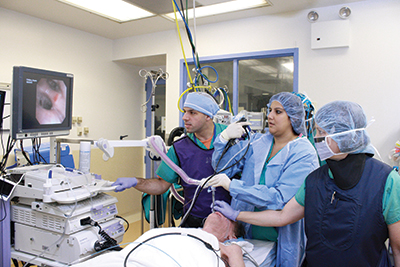NYM is Only Hospital in Brooklyn to Offer Navigational Bronchoscopy
Oct 12, 2011

Dr. Sonali Sethi (center) and her team performing the 5th navigational bronchoscopy at NYM in the Operating Room (OR).
New York Methodist Hospital's Comprehensive Lung Cancer Center (CLCC) now offers navigational bronchoscopy, a minimally invasive diagnostic procedure that provides new options for the diagnosis and treatment of lung disease.
Lung cancer is the number one cause of cancer-related deaths in the United States, among both men and women. The disease claims more lives than colon, prostate and breast cancer combined. Smoking accounts for about 85 to 90 percent of lung cancer cases, with other causes relating to secondhand smoke, air pollution, and exposure to asbestos.
Lung cancer can be treated at an early stage. Recent studies have demonstrated that about 80 percent of lung cancers could be cured if detected at an early stage, yet currently only 15 percent are caught at this stage. Lung screenings are recommended for individuals between the ages of 50 and 80 who have a family history of lung cancer, have a smoking history of at least one pack of cigarettes per day for 10 years, have a past history of smoking less than ten years ago, or have had repeated exposure to secondhand smoke or other cancer-causing agents such as asbestos or radon. Lung cancer screenings may be performed using standard chest x-rays, sputum cytology, or CT (computed tomography) scans, a procedure which involves a rotating, low-dose x-ray beam.
Previously, if a tumor or unknown mass was detected during the screening, a needle or surgical biopsy was performed. Both of these procedures could cause complications and discomfort.
Traditionally, bronchoscopy is a procedure used to examine the major air passages of the lungs through a thin lighted tube called a bronchoscope. This allows a physician to evaluate the lungs and collect small tissue samples to diagnose lung disease and lung cancer. However, traditional bronchoscopy cannot reach the distant regions of the lung, where more than two-thirds of all lung lesions are found.
Unlike traditional bronchoscopy, navigational bronchoscopy uses GPS-like technology to position small, flexible catheters deep into the lungs, using natural airway access. This allows physicians to take remote tissue samples that can lead to earlier diagnosis and staging of lung abnormalities. "With navigational bronchoscopy, recovery from biopsy is faster than for patients who have had more invasive biopsy procedures," said Suhail Raoof, M.D., chief of pulmonary and critical care medicine at NYM.
Navigational bronchoscopy can also be used to place markers in the lungs that guide radiation oncologists to a specific area that is targeted for treatment with radiation.
"We are currently the only hospital in Brooklyn to offer this new and important procedure," said Sonali Sethi, M.D., director of interventional pulmonology at NYM.
Media Contact:
Media Relations 718-780-5367



